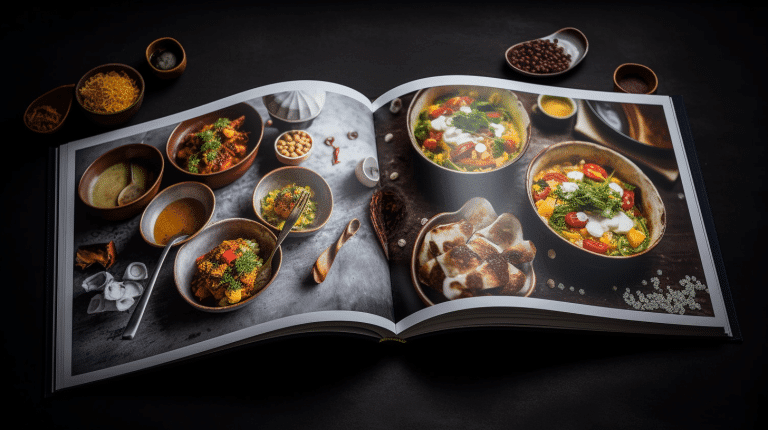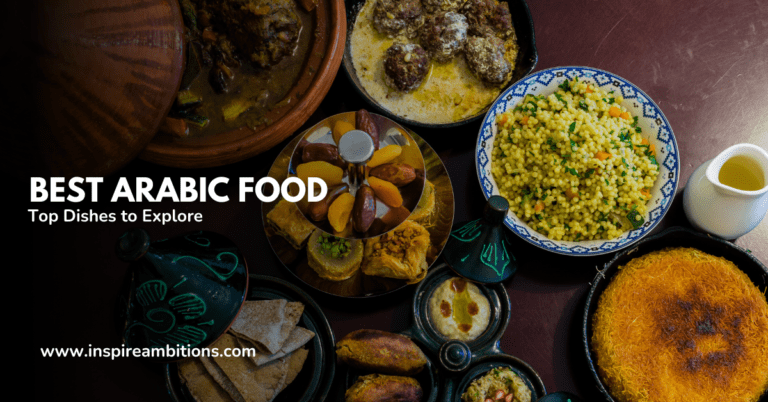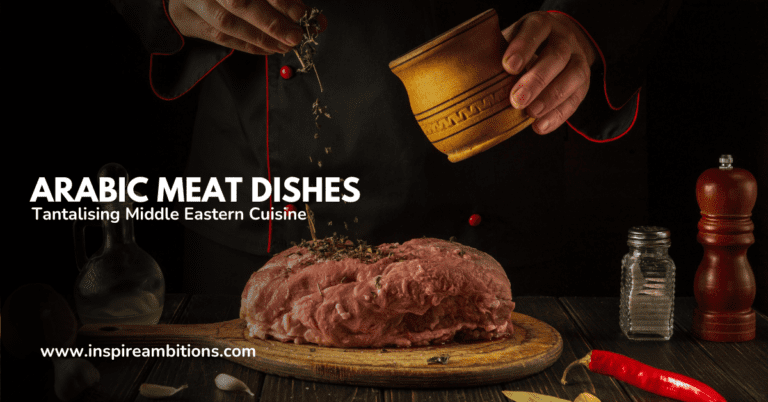Arabic Cuisine – A Comprehensive Guide to Delightful Dishes and Flavours
Arabic cuisine encompasses the culinary traditions of the Arab world, offering a delectable array of regional dishes from the Maghreb to the Fertile Crescent and the Arabian Peninsula.
These centuries-old cuisines reflect the rich cultural history of trading and exchanging ingredients, spices, herbs, and commodities across Arab nations.
One of the most striking features of Arabic cuisine is the symphony of flavours and fragrances, which beautifully combine spices, herbs and flower essences to create mouth-watering dishes.
Common ingredients such as turmeric, cumin, coriander, ginger, and cinnamon are generously used in various recipes. At the same time, signature flavours like sumac, lemon, pomegranate syrup, sour cherry, and plum define the unique taste of Arabic dishes.
As you explore the world of Arabic cuisine, you’ll discover an abundance of delicious dishes such as manakeesh, a round bread often regarded as the pizza of the Arabic world, and grilled halloumi, a salty cheese originating from Cyprus.
Additionally, lamb-based dishes like mansaf, made with yoghurt and rice, are popular choices for special occasions. Delving into Arabic cuisine promises to be an exciting and flavourful journey that will leave you wanting more.
Historical Roots of Arabic Cuisine
Arab cuisine, a vital part of the rich culture and history of the Arab world, has been shaped by a variety of influences spanning from the Maghreb to the Fertile Crescent and the Arabian Peninsula.
Throughout time, it has been significantly impacted by the trading of ingredients, spices, herbs, and commodities; each of these elements contributes to the distinctive flavours found in Arabic dishes you can enjoy today.
The origin of Arab cuisine can be traced back to the ancient civilisations of the Middle East, including the Sumerians, Babylonians, Phoenicians (or Canaanites), Hittites, Arameans, Assyrians, Egyptians, and Nabateans.
These groups all played a part in the formation of the Arab kitchen, as their distinctive culinary traditions blended over time.
Arabic cuisine continued to evolve and spread with the rise of the Islamic empire, particularly during the Umayyad and Abbasid dynasties. As the empire expanded, so did the influence of Arab culinary practices, which integrated foreign elements from other cultures that the Arab empire had come into contact with.
These encounters led to a fascinating exchange of techniques, ingredients, and flavours that enriched the Arabic gastronomic tapestry.
The Ottoman and Safavid empires also had a lasting impact on the development of Arabic cuisine, as they introduced dishes and ingredients from their territories, including modern-day Turkey and Iran. This blend of cultures and tastes truly illustrates the diverse and enduring culinary legacy of the Middle East.
You can appreciate the sophistication and variety of Arabic cuisine by exploring its use of aromatic spices such as cumin, coriander, and cinnamon, the prominence of grains like wheat, barley, and rice, and the incorporation of sweet fruits such as dates and figs.
With such a rich history and a broad span of influences, it’s no wonder that today’s Arabic cuisine is a treasure trove of delightful flavours and culinary ingenuity.
Key Ingredients Used in Arabic Cuisine
Arabic cuisine is rich in flavour and diversity, offering a range of dishes that boast a unique combination of spices, meats, vegetables, and grains. You would be amazed at the blend of tastes and textures you could experience from these key ingredients.
Spices
Arabic cuisine utilises a variety of spices to create distinct flavours. Some central spices include:
- Baharat: A complex spice blend that typically contains black pepper, cumin, cardamom, cinnamon, cloves, nutmeg, and paprika.
- Za’atar: A mix usually comprised of dried oregano, sesame seeds, sumac, salt, and ground caraway seeds.
- Sumac: A tangy and slightly sour spice, used to add zing to salads and other dishes.
- Cumin, Cinnamon, Nutmeg, and Cloves: These spices are commonly used individually or combined in dishes like Kibbeh, providing warmth and depth to the flavours.
Meats
In Arabic cuisine, meats are often marinated and slow-cooked to maximise tenderness and flavour. Popular meats include:
- Lamb: A popular choice for both grilled and stewed dishes.
- Chicken: Frequently used alongside fragrant spices in dishes like shawarma and kebabs.
- Fish: In coastal regions, local fish are often grilled or baked, with spices enhancing their flavour.
- Minced Meat: A common component of dishes such as Kibbeh and stuffed vegetables.
Vegetables
Arabic cuisine features an array of seasonal vegetables, often used as side dishes, mains, or dips. Some key examples include:
- Eggplant: A versatile vegetable used in dishes such as baba ghanoush, moussaka, or fried as a side.
- Chickpeas: Widely used in popular dishes like hummus, falafel, and stews.
- Okra: Commonly used in stews and salads, typically cooked with tomatoes and onions.
- Stuffed Vegetables: Peppers, tomatoes, or zucchini are often filled with a mixture of rice, meat, or nuts before cooking.
Grains
Grains are an essential component of Arabic cuisine, providing the base for many dishes:
- Bulgur: A type of wheat, often used for salads like tabbouleh or combined with minced meat in Kibbeh.
- Couscous: A North African staple, made from small steamed balls of crushed durum wheat semolina, served with vegetables or meats.
- Rice: Sometimes cooked and spiced in dishes like pilaf, or used as a plain accompaniment to stews and meats.
- Flatbreads: An everyday staple, enjoyed with dips like hummus and za’atar or used to wrap sandwiches and kebabs.
Popular Arabic Dishes
Arabic cuisine is rich and diverse, reflecting the influences of various regions and cultures. In this section, we will explore some popular Arabic dishes that you should try.
Mezze
Mezze is a selection of small dishes served as appetisers or starters in Arabic countries. Typically, it includes dishes such as:
- Hummus: a creamy dip made from chickpeas, tahini, lemon juice, garlic, and olive oil.
- Baba Ghanoush: a smoky eggplant dip, combined with tahini, garlic, and lemon juice.
- Tabbouleh: a fresh and zesty salad made from bulgur wheat, parsley, tomatoes, mint, and a lemon dressing.
- Falafel: deep-fried balls or patties made from ground chickpeas, fava beans, or both, seasoned with spices and herbs like coriander and cumin.
- Fattoush: a bread salad with mixed greens, fried Arabic bread, pomegranate, and a tangy dressing.
Kebabs
Kebabs are a popular form of grilled meat in Arabic cuisine, often served on skewers. Some well-known kebab varieties include:
- Shish Kebab: skewered and grilled cubes of marinated meat, usually lamb or chicken, served with rice, salad, or flatbread.
- Kofta Kebab: ground meat, usually minced lamb or beef, mixed with onions, parsley, and spices, formed into cylindrical shapes and grilled.
Shawarma
Shawarma is a popular street food in Arabic countries, made from marinated and spit-roasted meat such as lamb, chicken, or beef, thinly sliced and served in a folded pita or wrap.
The meat is often seasoned with a blend of spices, such as allspice, cinnamon, and cumin. Shawarma is typically accompanied by various toppings, like garlic sauce, tahini, pickles, and vegetables.
Mansaf
Mansaf is a traditional Jordanian dish made from lamb cooked in a sauce of fermented dried yoghurt called jameed, served over a bed of rice.
It is often garnished with almonds and pine nuts, and accompanied by flatbread. Mansaf is considered a celebratory dish and is shared among friends and family during special occasions.
These dishes offer a glimpse into the world of Arabic cuisine. Explore these flavours and expand your culinary horizons by trying these delicious dishes on your next visit to an Arabic restaurant or during your travels in the Middle East.
Regional Variations
Levantine Cuisine
In Levantine cuisine, you’ll find a diverse array of dishes originating from the Eastern Mediterranean region, which includes countries like Lebanon, Syria, and Palestine.
Expect to find a strong emphasis on fresh and seasonal produce, with a wide variety of vegetables, legumes, and grains. Popular dishes include tabbouleh, falafel, and hummus. Levantine cuisine is known for its:
- Mezze culture: small plates of appetisers served before the main course
- Use of olive oil, lemon, and garlic for seasoning
- Focus on whole grains, like bulgur wheat and freekeh
Maghreb Cuisine
Maghreb cuisine hails from the North African region encompassing countries such as Morocco, Algeria, and Tunisia.
With a rich history of culinary influences from Arab, Berber, and Mediterranean cultures, Maghreb cuisine offers a tantalising mix of flavours. You’ll often encounter:
- Use of bold spices like cumin, coriander, and paprika
- Slow-cooked dishes, like tagines and couscous
- Sweet-savoury combinations, like fruit-stuffed pastries or dishes with honey
Gulf Cuisine
Gulf cuisine, also known as Khaleeji cuisine, is the traditional Arabic cuisine of Eastern Arabia and the areas surrounding the Persian Gulf.
The coastal region places significant importance on seafood, making it a staple in their diet. Characteristics of Gulf cuisine include:
- Prominence of fish and seafood dishes, like grilled fish and shrimp stews
- Use of spices like saffron, cardamom, and cloves
- Date-based desserts and snacks, often paired with Arabic coffee
Throughout these regional variations, you’ll notice a common thread of shared ingredients and flavours – a testament to the vast and interconnected history of Arabic cuisine.
Arabic Cuisine Influences on Global Cookery
Arab cuisine has had a remarkable impact on global cookery, spreading its rich flavours, unique ingredients, and diverse techniques across continents. From the Middle East to Africa and Europe, various national dishes have been enriched by the Arabic culinary heritage.
In the Mediterranean region, for example, the Moors brought their culinary expertise to Spain during their occupation, resulting in the birth of Andalusian cuisine.
You may observe the use of saffron in Spanish dishes like paella, a traditional dish that owes its distinct flavour profile to the Arab occupation. Also, the consumption of ingredients such as almonds, pistachios, and apricots in traditional recipes is a testament to the Arabian influence.
You would find Arab influences in French cuisine as well. France is well-known for its delectable pastries, many of which, such as the tasty almond and honey-filled puff pastry known as ‘Bastilla’, have Arabic origins. The use of spices such as cumin and saffron in French gastronomy is another indication of the exchange of culinary flavours.
In North Africa, specifically Tunisia and Morocco, the Arab culinary tradition has left an indelible mark. Tajine, a Maghrebi dish named after the earthenware pot it is cooked in, is not only a beloved meal in Arab households but has also made its way into the international culinary scene.
Tunisian dishes, which make use of a dizzying array of spices, herbs, and aromatic ingredients, perfectly exemplify the unique flavours of North African cuisine that have been inspired by the Arabs.
Even within the Arab world itself, regional variations in cuisine are apparent. The use of seafood heavily influences Eastern Arabian cuisine around the Persian Gulf, resulting in quintessential dishes such as hamour (grouper fish) and maḥyawa, a local fish sauce.
As you can see, the Arab world has left an enduring gastronomic legacy across several cultures and countries. From the melding of spices to the innovative use of ingredients, your taste buds are sure to be delighted by the influence of Arabic cuisine in many global dishes.
Health Benefits of Arabic Cuisine
Arabic cuisine is not only flavourful but also boasts numerous health benefits. With its focus on plant-based proteins, healthy fats, fruits, vegetables, spices, seeds, grains, and herbs, it is considered one of the healthiest cuisines in the world.
One key benefit you’ll find in Arabic dishes is their ability to lower cholesterol and blood pressure. This is thanks to the incorporation of natural ingredients such as olive oil, legumes, fruits, and unrefined cereal products.
Consuming a diet rich in omega-3 fatty acids and good fats contributes to maintaining a healthy cardiovascular system.
Furthermore, Arabic cuisine often includes vitamin-rich salads like Tabbouleh. This particular salad includes finely chopped tomatoes, parsley, mint, bulgur, and onion, seasoned with olive oil, lemon juice, and salt.
If you prefer an extra boost of protein and fibre, you can substitute the bulgur with quinoa or couscous, which are indigenous to North Africa.
Additionally, Arabic food is abundant in diverse spices which not only add rich flavour but also provide various health benefits.
Some commonly used spices include cinnamon, turmeric, cumin, and coriander, all known for their potential to improve digestion, reduce inflammation and provide antioxidant properties.
When preparing Arabic dishes, be mindful of the cooking methods and ingredients to ensure they align with a healthy diet.
For instance, consider swapping out ghee, which is higher in fat content than regular butter, for healthier alternatives like olive oil or vegetable oil. This small change will allow you to enjoy the richness and depth of flavour while still providing nutritional benefits.
In summary, Arabic cuisine offers a wide range of delicious dishes that also promote a healthy lifestyle.
By incorporating nutrient-rich ingredients, utilising healthier cooking methods, and exploring the diverse flavours of Arabic food, you’ll find that this cuisine is not only tasty but also beneficial for your overall well-being.
Arabic Desserts
Arabic cuisine is recognised for its delightful and unique desserts. In this section, we will explore some of the most popular Arabic sweets and their flavours.
Baklava
Baklava is perhaps the most well-known dessert in Middle Eastern cuisine. This delectable treat is created by layering nuts, such as walnuts, pistachios, and hazelnuts, between thin sheets of phyllo dough.
The nuts are often flavoured with spices like cinnamon or cloves for an added depth of flavour. Baklava is then sweetened with a simple syrup made from sugar or honey, lending it a delightful sticky texture.
One of the keys to a good baklava is the crispiness of the phyllo dough. To achieve this, the pastry is typically baked at a high temperature until golden brown. The combination of flaky layers and sweet, nutty filling make it a truly indulgent treat.
Knafeh
Knafeh is another beloved Arabic dessert, particularly popular in Levantine cuisine. It is made from a special type of shredded phyllo dough called kadayif, which is layered with a sweet cheese or creamy filling.
The pastry is then soaked in a sugar syrup infused with flavours like orange blossom water or rose water.
Knafeh comes in various forms, but the most common version features a creamy layer sandwiched between two crispy layers of kadayif. It is often garnished with crushed pistachios, adding an appealing pop of colour and a contrast in texture.
Um Ali
Um Ali is a traditional Egyptian dessert resembling a bread pudding. It is made by combining pieces of puff pastry or phyllo dough with milk, sugar, and various spices such as cinnamon and nutmeg. The mixture is then baked until it forms a rich, custard-like texture.
This dessert can be further enhanced with the addition of ingredients like raisins, nuts, and coconut flakes. Um Ali is usually served warm, straight from the oven, and topped with a dusting of powdered sugar or a drizzle of honey.
These are just a few examples of the delightful and diverse range of Arabic desserts that await your palate. Each dessert carries its unique flavours and textures, offering you a delightful taste of the rich and diverse world of Arabic cuisine.
Beverages in Arab Cuisine
Arabic Coffee
Arabic coffee, or qahwa, is a significant part of Arabian hospitality and culture. It is typically made from lightly roasted arabica coffee beans, mixed with cardamom and sometimes flavoured with saffron or cloves.
In the Gulf region, it is traditionally served without sugar, and often accompanied by dates or sweets. Here’s how you prepare it:
- Crush the cardamom pods using a mortar and pestle or a coffee grinder.
- In a dallah (traditional Arabic coffee pot), combine the coffee grounds, cardamom, and any additional spices.
- Add water and bring the mixture to a boil over medium heat.
- Simmer for a few minutes, allowing the flavours to meld together.
- Pour the coffee through a strainer or fine-mesh sieve, and serve in small cups.
Savour the aroma and let the warmth envelop you as you enjoy this aromatic beverage.
Yemeni Tea
Yemeni tea, known as shay, is a strong, flavoursome tea often infused with spices and herbs such as mint, ginger, or cinnamon.
It is consumed extensively in Yemen, with meals and during social gatherings. It strikingly contrasts with the mild taste of Arabic coffee. Here is a basic recipe for making Yemeni tea:
- Add loose-leaf black tea to a teapot, around one teaspoon per serving.
- Pour boiling water into the pot and let the tea steep for about 5 minutes.
- Meanwhile, in a small saucepan, mix water, sugar, and your choice of spices (such as cardamom, ginger, or cinnamon).
- Boil the mixture until the sugar dissolves. You may adjust the amount of sugar depending on your taste preference.
- Add the spiced syrup to the teapot and stir.
- Serve hot, garnished with fresh mint leaves.
Experiment with various herbs and spices to find your perfect blend of Yemeni tea, as you immerse yourself in the diverse world of Arab beverages.






